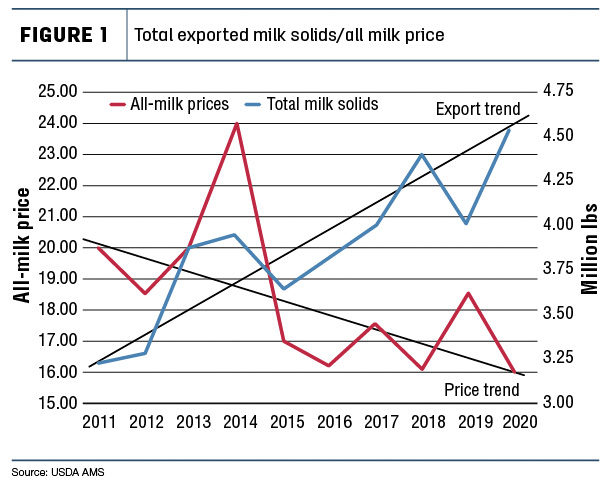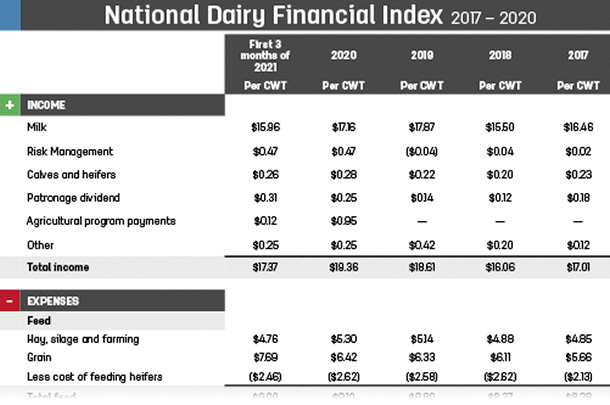The accompanying illustrated average cost index is the preliminary report from 50 of our national clients’ average operating results, comparing 2021 first-quarter results with the preceding four calendar years.
Click here or on the image above to view it at full size in a new window.
Dairy profitability
The first-quarter 2021 average cost index reflects a loss of $1.62 per hundredweight (cwt) and, when averaged with the other four years, all five periods show a combined net loss of 97 cents per cwt. This net loss for the last four-plus years is understandable when the constant increase in milk production each year is put into excessive Class III and IV products that cannot profitably be sold in world markets. The following graph comparing producers’ milk prices to the volume of milk products exported for the last 10 years convincingly illustrates the negative impact increased exports have had on producers’ milk check pay prices. A 45% increase in milk exports have yielded an average 20% decrease in producer pay prices over the last 10 years (see Figure 1).
Milk price
The greatest change in 2021 compared to 2020 is the milk price. The average cost index reflects a 2021 average milk price of $15.96 per cwt compared to the $17.16 per cwt milk price for 2020, a decline of $1.20 per cwt. With the illustrated total of expenses to operate a dairy farm well above $17 per cwt, plus the need for $1.33 for debt payments and an owner’s living allowance, dairy farmers will need about $19 per cwt paid to them for their milk to adequately cash flow their dairy farm operations.
Milk revenue is the largest single line item on dairy farmers’ profit/loss statements, but it is the operational obligation they spend the least amount of time working on. Co-ops handle about 85% of this nation’s milk and help non co-op handlers balance their privately owned plants. Properly administered using Capper-Volstead, a coordinated marketing plan among co-ops, who would seemingly have the ability to do so, could adopt and operate a plan to match the milk supply with profitable demand (from the producers’ prospective), thereby improving their co-op members’ milk price to sustainable levels and permanently keeping them there. If producers put quality time into this effort, it will be time well spent.
Feed costs
Dairy feed costs for the three months in 2021 have increased to $9.99 per cwt and represents 62.5% of the milk price. The previous four-year average feed cost percentage of milk prices was 51.5%. Therefore, feed costs as a percentage to milk price has increased by 11% this year.
Another way to illustrate this feed cost increase is to compare the 2021 feed cost of $9.99 per cwt to the average of the previous four-year average of $8.69 per cwt. This results in a feed cost increase of $1.30 per cwt of milk for 2021.
With current drought conditions in the West, the dairy feed crops outlook appears grim, and feed costs are likely to continue to rise in 2021 and 2022.
Other operating costs
A. Interest rates – We hear every day about how the Federal Reserve will have to increase interest rates to slow the national inflation rate. Each quarter percentage of interest rate hike will translate into a 5-cent-per- cwt cost increase.
B. Labor – Many states have adopted overtime pay rules for agriculture workers. Not only will wage expenses continue to go up because workers are harder to find and they demand higher wages; they will now be paid for overtime work hours. Along with higher wages are the increased payroll tax and workers’ compensation insurance costs. These combined increasing costs will total about 25 cents per cwt.
C. Fuel – Fuel costs have increased 33% in 2021. Everything delivered to the dairy and shipped off the dairy will increase operating expenses by as much as 25 cents per cwt.
D. Herd replacement cost – The cost to raise heifers, considering increases in feed, interest, labor and fuel costs could add up to about a 20-cent-per- cwt added cost. This can translate into an increased cost to raise heifers by $100 to $150 per head.
The old saying, “Not everything that counts can be counted and not everything that can be counted counts” applies to the current dairy farmer financial crunch. We accountants can keep counting, summarizing and measuring a farm’s profit or loss, but this by itself will not make farms sustainable. What we count on is that our co-ops continually provide their producer members with sustainable milk prices. I am told that “milk price” is not on co-op meeting agendas. If it was, we would not be losing $2 per cwt as is the current situation. ![]()
Gary Genske is a CPA with Genske Mulder & Company. Email Gary Genske.





